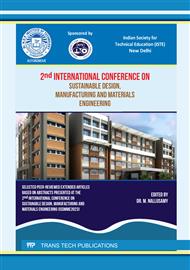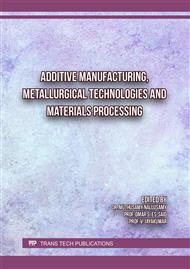[1]
V. Pandian and S. Kannan, "Numerical prediction and experimental investigation of aerospace-grade dissimilar aluminium alloy by friction stir welding," J. Manuf. Process., vol. 54, no. February, p.99–108, 2020.
DOI: 10.1016/j.jmapro.2020.03.001
Google Scholar
[2]
K. Sekar and P. Vasanthakumar, "Microstructural evaluation of similar and dissimilar welding of aluminum metal matrix hybrid composite by friction stir welding," Mater. Sci. Forum, vol. 979 MSF, p.124–128, 2020.
DOI: 10.4028/www.scientific.net/msf.979.124
Google Scholar
[3]
Suresh D. Meshram, G. Madhusudhan Reddy, and A. Venugopal Rao, Role of Threaded Tool Pin Profile and Rotational Speed on Generation of Defect Free Friction Stir AA 2014 Aluminium Alloy Weld, Defence Science Journal, Vol. 66, No. 1, 2016.
DOI: 10.14429/dsj.66.8566
Google Scholar
[4]
P. Vasanthakumar, K. Sekar, and J. Jayantherababu, "Thermal prediction and experimental validation of Friction Stir Welded Aerospace Grade Aluminium Alloy," J. Phys. Conf. Ser., vol. 1240, pp.1-12, 2019.
DOI: 10.1088/1742-6596/1240/1/012150
Google Scholar
[5]
Sekar. K, Vasanthakumar. P Friction Stir Welding of Al-Cu Alloy Metal Matrix Composites Reinforced with B4C and Graphite Particle Fabricated by Stir Casting and Thixoforming Method, M. S. Shunmugam and M. Kanthababu, "Advances in Additive Manufacturing and Joining," in Editors Proceedings of AIMTDR, 2018.
DOI: 10.1007/978-981-32-9433-2_44
Google Scholar
[6]
S. M. Bayazida, H. Farhangia, A. Ghahramania, Effect of Pin Profile on Defects of Friction Stir Welded 7075 Aluminium Alloy, Procedia Materials Science 11, 2015.
DOI: 10.1016/j.mspro.2015.11.013
Google Scholar
[7]
P. Bala Srinivasan, W. Dietzel , R. Zettler, J.F. dos Santos,V.Sivan, Stress corrosion cracking susceptibility of friction stir welded AA7075–AA6056 dissimilar joint, Materials Science and Engineering vol.392, pp.292-300, 2005.
DOI: 10.1016/j.msea.2004.09.065
Google Scholar
[8]
Y. Qiu, S. Thomas, D. Fabijanic, A. J. Barlow, H. L. Fraser, and N. Birbilis, "Microstructural evolution, electrochemical and corrosion properties of Al 2014 alloys" Mater. Des., vol. 170, p.107698, 2019.
DOI: 10.1016/j.matdes.2019.107698
Google Scholar
[9]
Z. Chen, Y. Mo, Z. Nie, Effect of Zn content on the microstructure and properties of super-high strength Al-Zn-Mg-Cu alloys, Metall. Mater. Trans. A vol. 44A, pp.3910-3920, 2013.
DOI: 10.1007/s11661-013-1731-x
Google Scholar
[10]
Beitao Guo, Zhongyu Zhang, Rongguang Li, Ultrasonic and eddy current non-destructive evaluation for property assessment of 6063 aluminium alloy, NDT and E International vol.93, p.34–39, 2018.
DOI: 10.1016/j.ndteint.2017.09.013
Google Scholar



